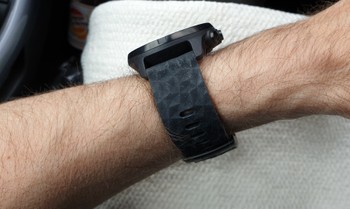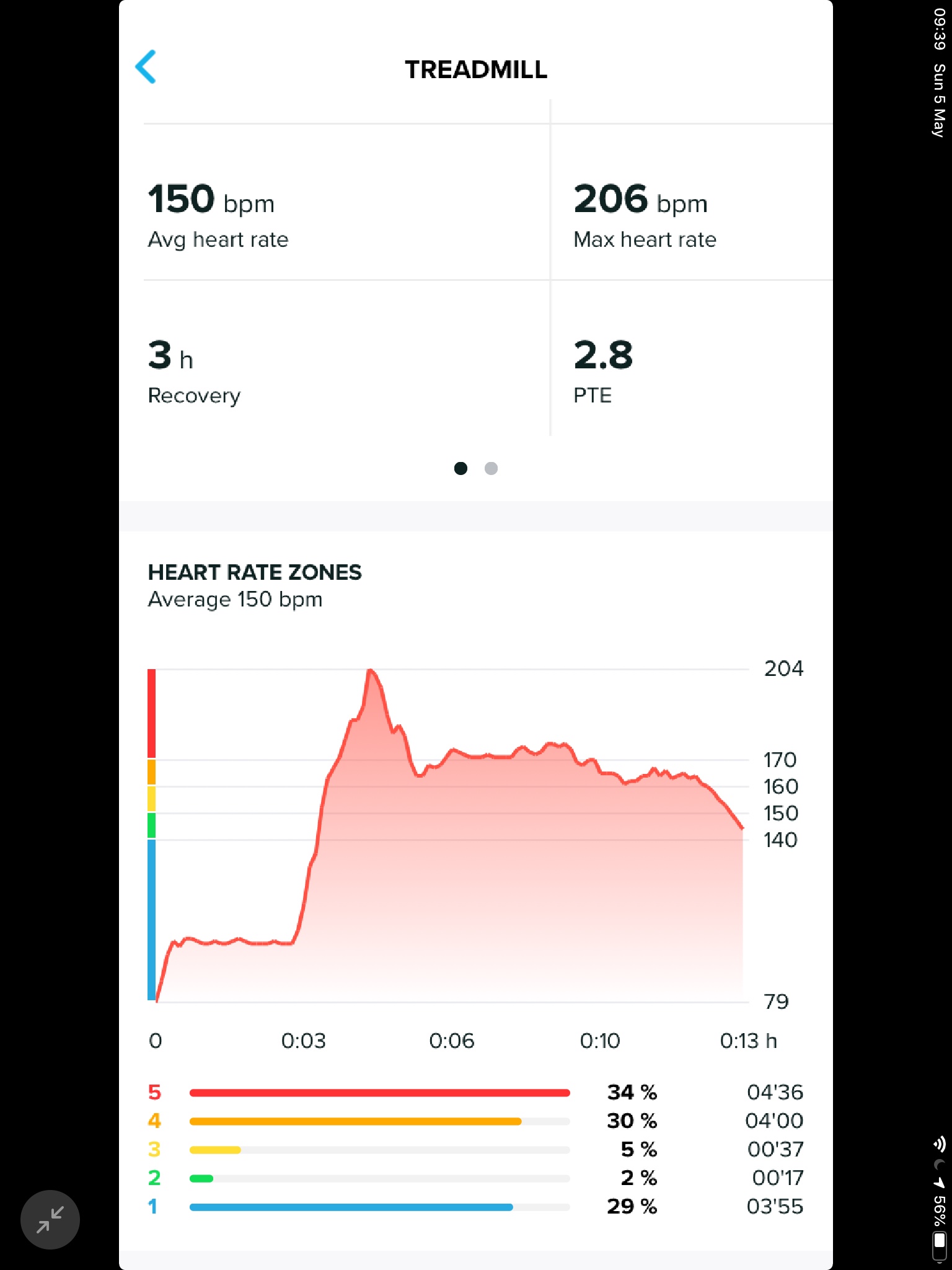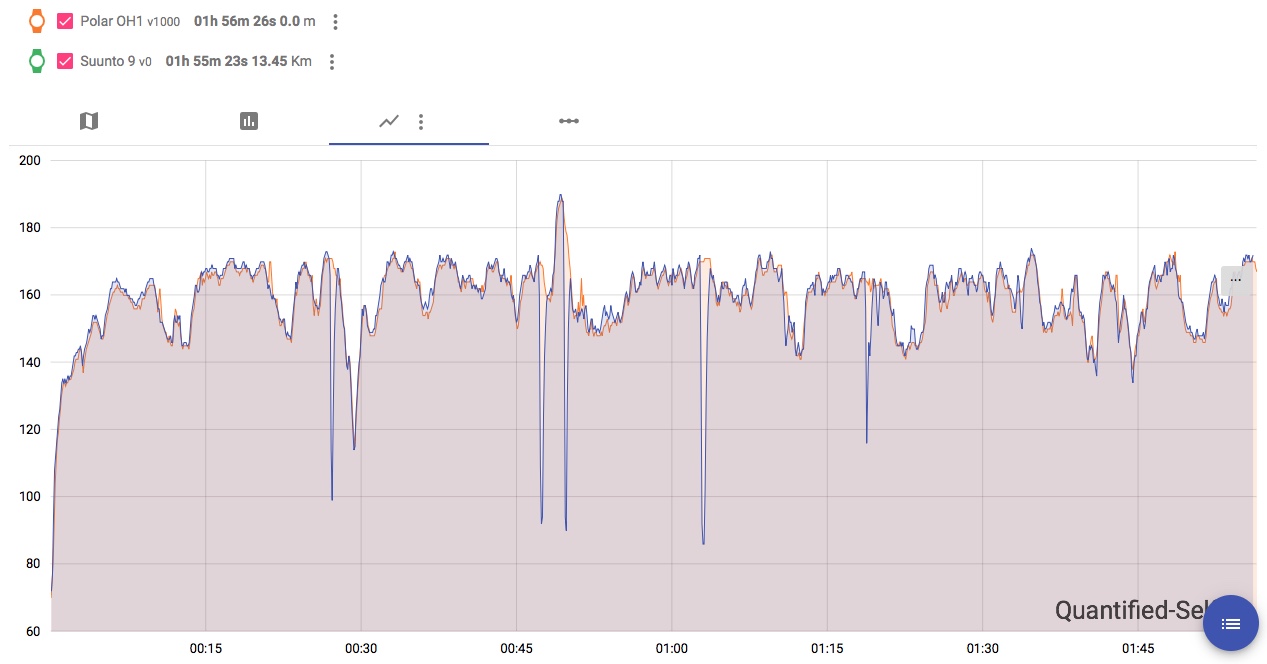-
@Dimitrios-Kanellopoulos tried it, didn’t work, still unrealistic hr for first 10 min.
-
@valdis830 said in Suunto 9 OHR readings:
More tricks to improve reading?
Use a chest strap

Suunto OHR has never worked for me (consistently 40bpm higher than actual). Chest strap fixes this for me. Can’t blame 'em, tattoos don’t play nice with OHR readings! -
Hi,
I just added this :
https://forum.suunto.com/topic/2374/heart-rate/6Cheers
-
Hi Guys,
Did you know that Suunto knows all these tips and tricks and there is whole blog on Suunto web site about this? And especially about warm-up before activity. Not only warm up for your body, but warm up for Heart Rate sensor as well
*If your watch shows inaccurate heart rate readings at the start of your exercises, a warm up may solve the issue:
Warm up for yourself: The quality of wrist-based HR measurement heavily depends on the blood flow to your arms and hands. A proper warm up for 10-15 minutes increases the blood flow and improves the quality of WHR readings.
AND
Warm up for the heart rate sensor: The sensor needs some time (several minutes) to lock on your heart rate. To give the sensor time to warm up, we recommend opening the exercise start screen already while getting ready for your workout (e.g. when changing clothes).*https://www.suunto.com/cs-cz/Content-pages/what-should-you-know-about-wrist-heart-rate2/
-
I tested a Suunto 9 and a Spartan Sport WHR Baro for cycling. Both gave me bad OHR values. I used all tips and tricks given from Suunto.
Then I placed the watches on my right arm/wrist and was astonished to have usable values immediately. Not only once, but ongoing.
May be this is worth trying for other people too.
-
-
@Dimitrios-Kanellopoulos said in Suunto 9 OHR readings:
this ?
Ah, okay, I didn’t read it before.
Yes, I can confirm this. The same 2 - 3 cm behind the wrist, the same width of the strap, just the other (right) arm.
-
@pilleus Perhaps we need to make a poll about this ?
-
For me, with Spartan Sport WHR Baro OHR doesn’t work no matter what I do. I didn’t try yet to jump on my right foot during the full moon spitting behind my left shoulder
 Usually, I use the chest strap and whenever I forget it or for some reason it won’t connect ( this week I totally forgot that I left the watch in airplane mode and used OHR during cycling accidentally ) the HR I get is rubbish. In my case it’s a lot lower than if should be, almost near my resting HR recording values 50-60bpm during activities like cycling, running or HIIT circuit. Sometimes it elevates 100-130 just to drop down again and in some cases I am not able to re-adjust my watch every few seconds measuring 2 inches from my wrist etc. Considering other devices I have been using, OHR in Suunto is the worst I have experienced so far. If not that I can pair it with the chest strap I would probably switch already to something else.
Usually, I use the chest strap and whenever I forget it or for some reason it won’t connect ( this week I totally forgot that I left the watch in airplane mode and used OHR during cycling accidentally ) the HR I get is rubbish. In my case it’s a lot lower than if should be, almost near my resting HR recording values 50-60bpm during activities like cycling, running or HIIT circuit. Sometimes it elevates 100-130 just to drop down again and in some cases I am not able to re-adjust my watch every few seconds measuring 2 inches from my wrist etc. Considering other devices I have been using, OHR in Suunto is the worst I have experienced so far. If not that I can pair it with the chest strap I would probably switch already to something else. -
@jsr184 Same for me. I avoid using OHR as much as possible. But yesterday I had issues with my Polar H10 and had to use OHR for a short warmup on treadmill. OHR was correct in the beginning of the warm-up, but once I picked up the pace it shot up to 185, and then to 200+. I am pretty sure my actual HR at that moment was in upper 150s or lower 160s.
By the way, a bit of off-topic - my Polar H10 HRM fully discharges battery in about 3 months. It has just gone through the second battery in about 6-7 months of usage. Is that only me who has this issue?
-
Just to give my 2 cents … currently using a Suunto 9 and before a Spartan Sport WHR, and I am usually quote fine with the OHR with both watches.
Usually means: excellent results while cycling, walking, hiking and on a stationary bike, very good results on an elliptical trainer and while doing “street runs” and not too rugged/technical trail runs, really acceptable while doing technical trail runs and … not so good (and I knew it before because of the movement) while rowing and during cross training / weights. -
@Shrek3k said in Suunto 9 OHR readings:
I am usually quote fine
On the left arm/wrist? How strong is the strap fixed? Can you show us the exact position (behind the wrist, 2 cm or 3 cm)?
Thanks for your advice!
-
Hi all,
Just to avoid misunterstandings, In my case, I had to change the watch to my right wrist because I’m right-handed, if one is left-handed, so left wirst it’s the dominant wrist.@Dimitrios-Kanellopoulos if you do a poll about this, my sugestion is to use "dominant " and "non-dominant " wrist, to keep it clear

Cheers
-
@pilleus said in Suunto 9 OHR readings:
@Shrek3k said in Suunto 9 OHR readings:
I am usually quote fine
On the left arm/wrist? How strong is the strap fixed? Can you show us the exact position (behind the wrist, 2 cm or 3 cm)?
Thanks for your advice!
Apologies for forgetting to mention these details: left wrist (slightly higher (approx 3 cm) and tighter than usually / during “regular hours” ) … more or less tighter one notch, then pushed up until it “feels good, tight, but comfortable”, and it is my non-dominant side, as I am right-handed (not very scientific
 )
)
-
@Shrek3k thanks, my experience is the same, just on the right arm.
In my opinion it’s a difference between running/walking and cycling. The problems happen during cycling, never during running/walking.
-
BTW feel free to vote
-
@pilleus I agree that there seems to be or is a difference between cycling and walking/running. But for me it seems to be better when cycling - as long as I avoid cobblestone and give the watch some to “soak” (feels like a waste of time and is rather annoying but seems to be worth the time).
-
@Dimitrios-Kanellopoulos said in Suunto 9 OHR readings:
BTW feel free to vote
Before voting I for example need to try the other arm which I have not used with / tried for OHR as I have been able to receive acceptable results on my “usual” arm …
-
This week on the treadmill.
First 3 minutes not accurate then a jump at 206bpm then was I would say accurate.
then was I would say accurate.
-
This post is deleted!
